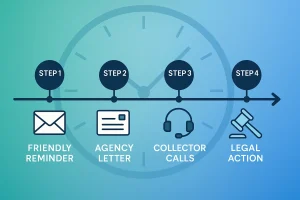1. The clock starts ticking the day an invoice turns 30-days past due
- Why speed matters: Industry analysts estimate recovery chances slip roughly one percentage point every week after the due date. By six months, even A-rated agencies collect only a third of what they could have captured in month one.
- Example: A Colorado dental practice placed 40 past-due patient invoices at just 35 days late. Within six weeks, they had pocketed 31 payments—an 77 % liquidation rate. A sister clinic waited until day 120 and recovered just 24 % on a nearly identical batch.
2. The Four-Step Collection Continuum
| Step | Ideal Age of Debt | Who Contacts Debtor | Typical Cost | Expected Liquidation* | Best For |
|---|---|---|---|---|---|
| Step 1 – Friendly Reminders (“Pre-Collections”) | 30-45 days | Your name & branding | Flat fee ≈ $15 | Up to 70 % | First-cycle delinquencies, small balances |
| Step 2 – Agency Letters | 60-120 days | Agency letterhead | Same flat fee | 50-70 % | Accounts that ignored Step 1 |
| Step 3 – Professional Collector Calls | 120 + days | Live collectors | Contingency 35-50 % | 20-40 % | Higher balances, chronic non-responders |
| Step 4 – Legal Action | Post-Step 3 or very high balance | Attorneys | Filing costs + higher contingency | Rare—but highest dollar yield | Debts with assets to levy or liens to file |
*Results vary by industry, documentation, and credit profile.
3. Step-by-Step Deep Dive with Mini-Case Studies
Step 1: Five-Touch Gentle Nudge
- What happens: Five escalating letters or emails mailed under your logo. You keep every dime collected.
- Mini-case: A boutique gym sent 220 members to a pre-collection letter service at 38 days late. Total flat-fee spend: $3,300. Fast-forward three weeks—$27,000 in membership dues hit their bank.
Step 2: Certified Agency Letters
- Adds third-party gravitas—return address now reads “Professional Debt Collection Agency.”
- Mini-case: A wholesale HVAC supplier skipped Step 1 and placed 19 invoices (avg. $1,800) at 75 days late. After two agency letters, 12 customers paid in full, 4 started payment plans, and only 3 progressed to phone collections.
Step 3: Human Calls & Negotiation
- Live collectors work within the “7 calls in 7 days” rule, so persuasion—not robo-dial volume—wins.
- Mini-case: An e-commerce brand escalated 600 aged orders (avg. $420) at 150 days past due. The agency’s skip-trace located 85 new cell numbers, and skilled negotiators closed $102,000 within sixty days—on a pure contingency fee.
Step 4: Litigation
- Only about 2 % of files merit a lawsuit once an asset search is done.
- Mini-case: A commercial landlord had a tenant default on $68,000 in rent. The agency’s attorney filed, won judgment, and garnished the tenant’s merchant-card deposits—recovering 92 % after costs.
4. Compliance & Good-Will Checkpoints
- FDCPA & Reg F: Ensure dialer logic respects the “7-in-7” call cap and the model validation notice.
- Data Security: Use agencies that can show SOC-2 reports or HIPAA Business Associate Agreements for medical files.
- Tone Matters: In post-collection surveys, 54 % of debtors said they paid sooner because letters sounded respectful rather than threatening.
5. Quick Decision Matrix
- Balance under $500 & < 45 days late? → Step 1.
- Multiple reminders ignored & 60-120 days late? → Step 2.
- Over 120 days OR balance > $1,000? → Step 3.
- Assets located & claim > $5,000? → Ask if Step 4 pencils out.
Bottom Line
Every month you delay moves an invoice closer to the industry’s 20 % recovery gutter. Place accounts early, escalate methodically, and lean on agencies that blend fixed-fee economy with contingency muscle. Still unsure? Drop us a note—NexaCollect will match you with a vetted, fully compliant partner by tomorrow morning.
